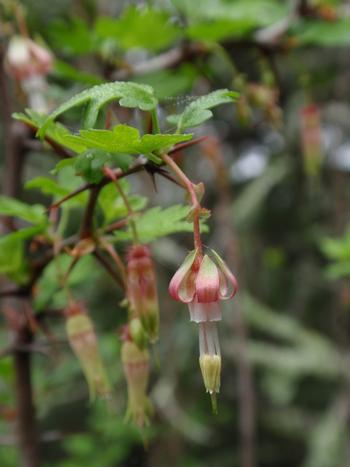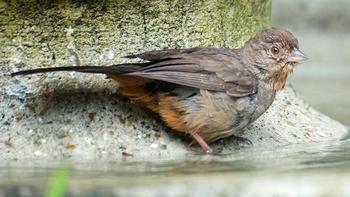Gardening for the birds
-
James Campbell
-
As home gardeners, we often think about the benefits of plants for our own enjoyment and viewing pleasure. However, it's important to remember that our gardens also play a vital role in supporting wildlife. Birds, insects, and other animals rely on plants for food, shelter, and nesting sites. By understanding how birds use plants, we can make informed choices about which species to include in our gardens.
 The juicy berries produced by this California ribes are a delight for many bird species. Photo: Tom Hilton
The juicy berries produced by this California ribes are a delight for many bird species. Photo: Tom HiltonOne of the primary ways that birds use plants is for food. Many species of Marin birds, including finches, sparrows, and warblers, rely on seeds and berries for sustenance. Most native California annuals provide seeds that birds relish. Try growing tidy tips, Farewell-to-Spring, or Baby Blue Eyes in your garden. Much of our native birdlife has co-evolved with our native plants, but plenty of nonnative plants can be beneficial too. If you have ever planted zinnias or sunflowers in your garden, you know how much birds love these seeds.
Native shrubs such as coffeeberry and ribes produce juicy berries adored by jays, purple finch, mockingbirds, robins, and band-tailed pigeons. Elderberries are at the top of almost every bird's list of favorite delicacies.
Hummingbirds come to the garden for insects and nectar—native herbaceous plants like columbine, penstemons, and monkeyflower. Flowering sages and huchera provide a great source of nectar and are sure to invite hummingbirds as regular visitors to your garden. Hummingbirds are highly attracted to plants with tubular red flowers. I see them daily on my grevalia, an Australian native well adapted to our summer dry climate.
Native plants can do double duty feeding birdlife. For example, a western redbud's flowers provide nectar for hummingbirds, while goldfinches will eat the seed. An Oregon grape provides nectar for hummingbirds and fruit for robins, towhee, and finches. A Madrone tree will feed band-tailed pigeons and black-headed grosbeaks who will eat the flowers and flickers, song sparrows, robins, cedar waxwings, and thrushes who will eat the fruit. Hummingbirds enjoy the nectar of this Western redbud, Cercis occidentalis, and goldfinches will feast on its seeds. Photo: David A Hofmann
Hummingbirds enjoy the nectar of this Western redbud, Cercis occidentalis, and goldfinches will feast on its seeds. Photo: David A HofmannMany native plants attract insects, providing another vital food source for birds in the garden. Coyotebush provides seeds for food and shelter for the nests of the gold-crowned sparrow Coyotebush also attracts insects that feed many other bird species. A native maple's seeds and flowers will be eaten by goldfinches, black-headed grosbeaks, and evening grosbeaks, while warblers, kinglets, bushtits, and vireos will feed on insects in the tree. One of the greatest bird trees is the oak. Acorns and insects provide food to many bird species. Oaks are also excellent nest sites for birds like the oak titmouse that loves to build in oak tree cavities.
An important function of plants in the garden is to provide shelter and nesting sites for wildlife. Shrubs, bushes, and trees offer protective cover for birds and other animals, allowing them to hide from predators and roost at night. Certain species, such as the California towhee, found in most Marin gardens, prefer low-growing shrubs and thickets. By including a variety of plant types and sizes in the garden, you can help provide nesting sites for a range of species.Of course, while it's important to consider the needs of wildlife in the garden, we also need to balance these concerns with our own desires and preferences as gardeners. In some cases, certain species may be more attractive to wildlife than we would like. For example, fruit trees can be a popular food source for birds, and rats so may require additional protection to ensure a good harvest for the gardener. California towhee taking a bath in Mill Valley. These birds prefer low shrubs for nesting & can be found in most Marin gardens. Photo: Veit Irtenkauf
California towhee taking a bath in Mill Valley. These birds prefer low shrubs for nesting & can be found in most Marin gardens. Photo: Veit IrtenkaufBy incorporating wildlife-friendly plants and practices into our gardens, we can create a thriving ecosystem that benefits both ourselves and the natural world around us. Whether you're a seasoned gardener or just getting started, there's always more to learn about how to create a sustainable and vibrant garden environment. Learn more about earth-friendly gardening https://marinmg.ucanr.edu/BASICS/EARTHFRIENDLY/.



